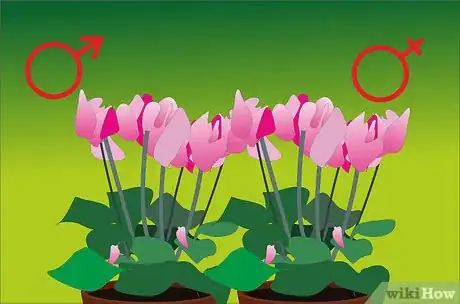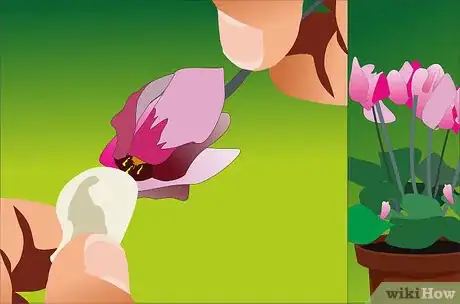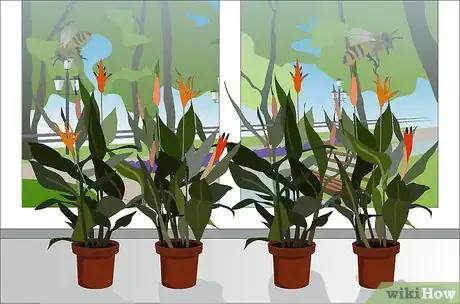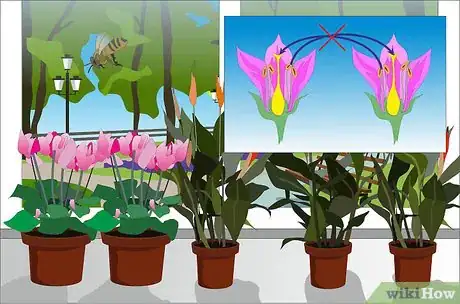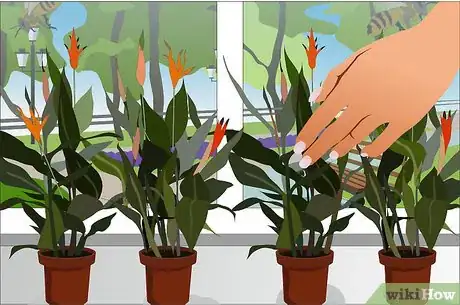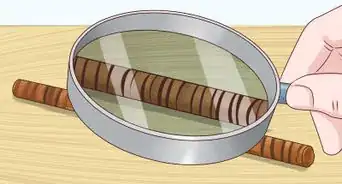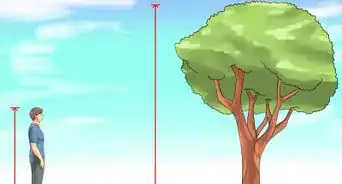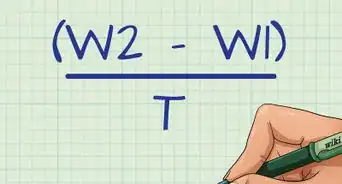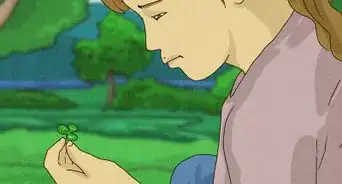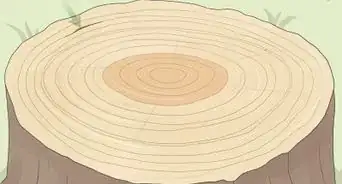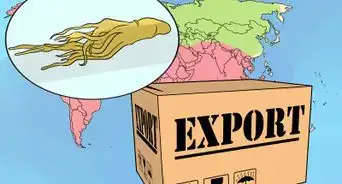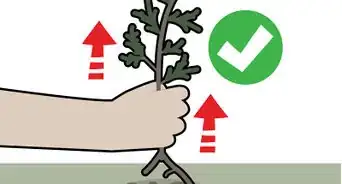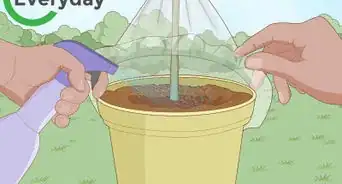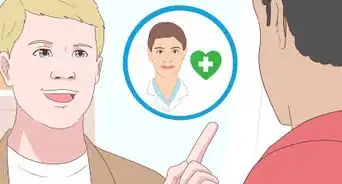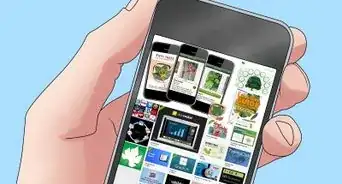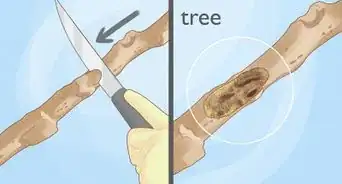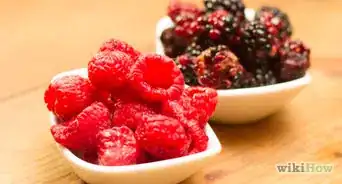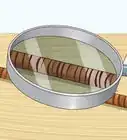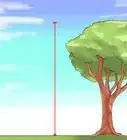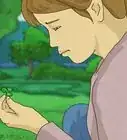This article was co-authored by Maggie Moran. Maggie Moran is a Professional Gardener in Pennsylvania.
This article has been viewed 92,204 times.
Flower pollination is the transmitting of pollen from a stamen to an ovule. Some flowers contain male and female parts, and pollination can occur by transferring pollen from the male organ to the female organ in the same plant. Pollination occurs naturally by animals, wind, or self-pollination. Sometimes, a person needs to intervene and pollinate flowers by hand.
Steps
Cross-Pollinating Flowers
-
1Identify the male and female parts of the flower. Flowers are the reproductive parts of plants. They have male parts called stamen and female parts called the pistil. The stamen produce pollen, and the pistil attaches to the ovule.[1]
- When pollen reaches the ovule, the flower is fertilized (or pollinated).
-
2Collect pollen from one flower. Touch the stamen of one flower with a small brush or cotton swab. Some of the pollen will stick to the brush. This allows you to transfer the pollen from that stamen to another flower.
- If the flowers are far apart, scrape the pollen into a gelatin capsule. Gelatin capsules are clear tablets that you can separate and fill with herbs or powdery substances, such as pollen. When transferring pollen, you don't want to risk losing the pollen you collect.
Advertisement -
3Take the pollen to another flower. With your pollen coated brush or cotton swab, touch the stigma of the other flower. The stigma is the top of the pistil that is designed to collect pollen and transfer it to the ovule. Coat the stigma as best you can with the pollen.
Self-Pollinating Flowers
-
1Identify organs located on the flowers for self-pollinating plants. Most flowers that are considered annuals are self-pollinating. Each self-pollinating flower has a stamen to produce pollen, a stigma to collect pollen, and a pistil leading to the ovule. Identify these structures in the flower. This will allow you to collect and move pollen to and from the correct structures.[2]
- The stamina (or stamens) look like little antennae that carry pollen.
- The pistil is usually in the center of the flower, and the stigma is on top of the pistil.
- The ovule can be found at the base of the pistil.
- Some self-pollinating flowers, such as lilies and roses, are also capable of cross-pollination.
-
2Collect pollen from the stamina. Use a brush or cotton swab to touch the stamen of your flower. Be careful not to push too hard with your brush. Coat the brush as well as you can with pollen to ensure an effective pollination.
-
3Transfer the pollen to the ovule. Pollen reaches the ovule by travelling down the pistil. The stop of the pistil, or stigma, is designed to collect pollen and move it down to the ovule. Use your brush to transfer pollen onto the stigma.
Determining the Need to Pollinate by Hand
-
1Pollinate indoor plants. Plants have many natural pollinators. Bees, flies, and even wind serve to pollinate plants in their natural habitat. Indoor plants are sheltered from these animals and elements. To compensate for this, pollinate indoor plants by hand.
-
2Transfer pollen to outdoor plants that are not getting pollinated naturally. If your flowers on fruit trees are dying before the fruit sets in, flower pollination may not be occurring. One reason for this might be that the pollinator that typically pollinates that plant (for example a particular species of moth) does not live in your area. This can happen if you have plants that are not naturally found in your region. You will need to pollinate these plants by hand.
-
3Use hand pollination to create hybrid flowers. By hand pollinating, you can select exactly which two flowers you want to cross. This allows you to create flowers that exhibit specific traits. Hybrid flowers may be a new color, grow taller, or have some other feature that neither of the parent flowers has.[3]
Expert Q&A
-
QuestionCan humans pollinate flowers?
 Lauren KurtzLauren Kurtz is a Naturalist and Horticultural Specialist. Lauren has worked for Aurora, Colorado managing the Water-Wise Garden at Aurora Municipal Center for the Water Conservation Department. She earned a BA in Environmental and Sustainability Studies from Western Michigan University in 2014.
Lauren KurtzLauren Kurtz is a Naturalist and Horticultural Specialist. Lauren has worked for Aurora, Colorado managing the Water-Wise Garden at Aurora Municipal Center for the Water Conservation Department. She earned a BA in Environmental and Sustainability Studies from Western Michigan University in 2014.
Professional Gardener Yes. Depending on the flower, a person can take a small tipped paint brush to transfer pollen from flower to flower to increase fruit set or hybridize different varieties.
Yes. Depending on the flower, a person can take a small tipped paint brush to transfer pollen from flower to flower to increase fruit set or hybridize different varieties. -
QuestionHow does a rose pollinate?
 Lauren KurtzLauren Kurtz is a Naturalist and Horticultural Specialist. Lauren has worked for Aurora, Colorado managing the Water-Wise Garden at Aurora Municipal Center for the Water Conservation Department. She earned a BA in Environmental and Sustainability Studies from Western Michigan University in 2014.
Lauren KurtzLauren Kurtz is a Naturalist and Horticultural Specialist. Lauren has worked for Aurora, Colorado managing the Water-Wise Garden at Aurora Municipal Center for the Water Conservation Department. She earned a BA in Environmental and Sustainability Studies from Western Michigan University in 2014.
Professional Gardener Insects visit the flowers to drink nectar and collect pollen then visit another flower to do the same and, consequently, transfer pollen from flower to flower or plant to plant. People can pollinate roses in situations where natural pollination isn't possible such as indoors or to create new hybrid varieties.
Insects visit the flowers to drink nectar and collect pollen then visit another flower to do the same and, consequently, transfer pollen from flower to flower or plant to plant. People can pollinate roses in situations where natural pollination isn't possible such as indoors or to create new hybrid varieties. -
QuestionHow do you pollinate pumpkins?
 Lauren KurtzLauren Kurtz is a Naturalist and Horticultural Specialist. Lauren has worked for Aurora, Colorado managing the Water-Wise Garden at Aurora Municipal Center for the Water Conservation Department. She earned a BA in Environmental and Sustainability Studies from Western Michigan University in 2014.
Lauren KurtzLauren Kurtz is a Naturalist and Horticultural Specialist. Lauren has worked for Aurora, Colorado managing the Water-Wise Garden at Aurora Municipal Center for the Water Conservation Department. She earned a BA in Environmental and Sustainability Studies from Western Michigan University in 2014.
Professional Gardener Insects pollinate pumpkins. Bees visit flowers to drink nectar and get covered with pollen then visit another flower, transferring the pollen and fertilizing the plant. People can also pollinate pumpkins with a small tipped paintbrush. Transfer pollen from a male flower to a female flower in the morning soon after the flowers have opened.
Insects pollinate pumpkins. Bees visit flowers to drink nectar and get covered with pollen then visit another flower, transferring the pollen and fertilizing the plant. People can also pollinate pumpkins with a small tipped paintbrush. Transfer pollen from a male flower to a female flower in the morning soon after the flowers have opened.
Things You'll Need
- Flowers
- Brush or cotton swab
- Gelatin capsule
References
About This Article
Flowers naturally pollinate themselves through various methods, but you may need to pollinate your flowers if they’re indoors, if they’re not getting pollinated naturally, or if you want to create hybrid flowers. To pollinate a flower, all you need to do is touch a small brush or cotton swab to its stamen and gently rub it against the stigma to transfer the pollen. The stamens look like little antennae that carry pollen, while the stigma is in the center of the flower. Transfer pollen to the same flower to self-pollinate it, or transfer it to a different flower to cross-pollinate it. If the flowers are far apart, scrape the pollen into a gelatin capsule to store it in the meantime. For more tips from our Gardening co-author, including other reasons your flowers might not be growing properly, read on!
